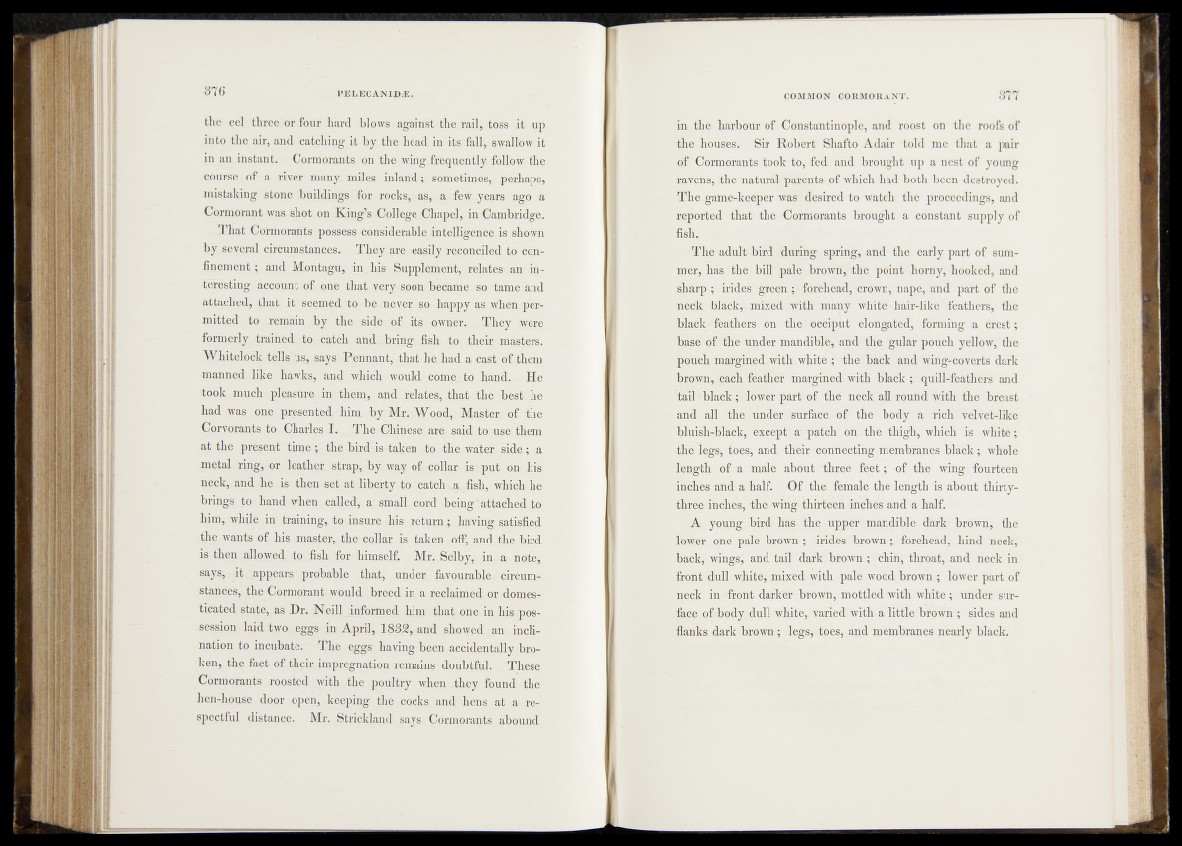
the eel three or four hard, blows against the rail, tuss it up
into the air, and catching it by the head in its fall, swallow it
in an instant. Cormorants on the wing frequently follow the
course of a river many miles inland; sometimes, perhaps,
mistaking stone buildings for rocks, as, a few years ago a
Cormorant was shot on King’s College ;ChapeT, in Cambridge.
That Cormorants possess considerable intelligence is1sh.©wn
by several circumstances. They are easily reconciled to confinement
; and Montagu, in . his Supplement, relates an interesting
account bf_one that very spoil ■ became $o tame and
attached, that it seemed to be never |;|g happy as when permitted
to remain .by th e s id e -b f-its owner. -They were
formerly trained to .catch and_bring fish t,o< ihe®'masters.
Whiteloek tells||s,-sajs Pennant, that he had a cask\©Sthem
manned like JjawkS, and "which would come to hand: Hi©
took much pleasure in, them, and^relates, tha^/th^ best. thfe
had was one presented .him b y -M m ^o o d , Ma7ster Jpf -the
Corvorants to Charles I .;, The Chinese, are- said to|use them
at the present time* the-bird is-taken to the water side; a
metal ring, or leather strap,, by way of c^lfp^is puMqn his
neck, and he . is then-set af lib.erty;!.to catlch.va. |igh, whi^he-
-brings, to ‘ hand whehi-called, a small --©©ad ?being; attached,tp1
him,-while iUTmining, tp.m&ureihis -r.etuiai.;- havin'^satisfied
the wants of h is master, the,collar is taken tt0^,and;f e |bird
is then allowed, ta jis h for himself. Mrv,Selby, in , a. note,
says,;-it;..appears probable that, under fibrnnstances,
the Cormorant wgjild breed -reclaimed or domesticated
state, as Dr. Neill .informed him thai$.Qg^in hispos-
session laid two eggs in April, 1 8 3 ^ a n d showed an inclination
to incubate. The eggs havingibeeh accidentally broken,
the fact of their impregnation remains doubtful. These
Cormorants roosted with the poultry whemthey fpund the.
hen-house dqpr open, keeping the cocks and % £ v*at
spectful distance. Mr. Strickland says. Cormorants abound
in the harbour of Constantinople, and roost on the roofs of
the houses. Sir Robert Shafto Adair told me that a pair
of Cormorants took to, fed and brought up a nest of young
yavens;! <the natural parents of which had both been destroyed.
The game-keeper was*- desired to watch the proceedings, and
reported that the Cormorants brought a constant supply of
fish,
The adult bird during spring, and the early part of summer,
has tlief bill pale; brown, the point homy, hooked, and
-sharp ; irides 'green ;!; forehead-, crown, nape, and part of the
neck black,-mixed with -id&^lflfif^hair-like ' feathers, the
/feathe^^ffe;^tKo^o^ccipfit?^Ibigated, fqrming a crest;
-basn^of • the7%idek mandible, an’d the gular pouch yellow, the
pouch margined wi@1'white t-f^ll^babk and wing-'coverts dark
b|&n-,leach fdaifier^hirgnfedl* y ith black ; quill-feathers and
tail M^felfjll^wer part of the neck all round with the breast
and <fJl&t h c T . s u n facej of *fillipbody a'- rich velvet-like
bMish^black;^ex'@ept1?#p’^cte\onT therthigh, which is white;
-tLordeg^tw^S and theif 'no^hectitf^membranes black; whole
ftig th of-a -male--about .ffiet; of t fe wing fourteen
inches'and a half. - O f, thei|female the length is about thirty-
■iteee ihche'S^'lthelwing ihhfebh ihehes*hind a half.
A ypuaig, bird has th ^p p p e r mandible dark brown, the
lbwe'rBie paleVbrowm; Ariillp brown; forehead, hind neck,
^atlk^wmgsj and tail’ dark brown,; chin’, throat, and neck in
jfeont white, mixefl^ith -pale wood.|Mqwn,; lower part of
neck in front d^rkbr sbrown,-< mottled with white; binder sur-
fiua© (^lo,|y^dull whit©,l%jped with a little broWn ; sides and
flanks dark brown*; legs^-toes, and membranes nearly black.